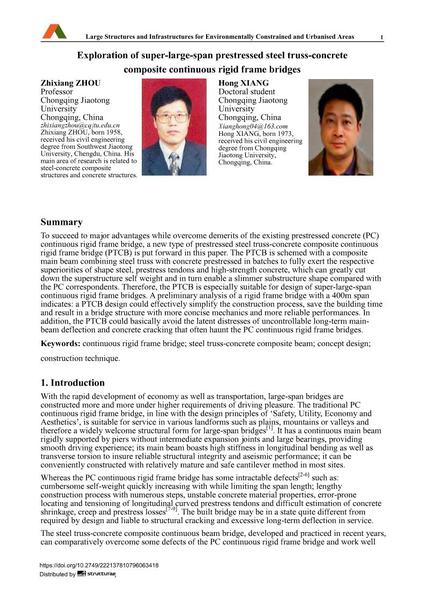Exploration of super-large-span prestressed steel truss-concrete composite continuous rigid frame bridges

|
|
|||||||||||
Détails bibliographiques
| Auteur(s): |
Zhixiang Zhou
Hong Xiang |
||||
|---|---|---|---|---|---|
| Médium: | papier de conférence | ||||
| Langue(s): | anglais | ||||
| Conférence: | IABSE Symposium: Large Structures and Infrastructures for Environmentally Constrained and Urbanised Areas, Venice, Italy, 22-24 September 2010 | ||||
| Publié dans: | IABSE Symposium Venice 2010 | ||||
|
|||||
| Page(s): | 710-711 | ||||
| Nombre total de pages (du PDF): | 8 | ||||
| Année: | 2010 | ||||
| DOI: | 10.2749/222137810796063418 | ||||
| Abstrait: |
To succeed to major advantages while overcome demerits of the existing prestressed concrete (PC) continuous rigid frame bridge, a new type of prestressed steel truss-concrete composite continuous rigid frame bridge (PTCB) is put forward in this paper. The PTCB is schemed with a composite main beam combining steel truss with concrete prestressed in batches to fully exert the respective superiorities of shape steel, prestress tendons and high-strength concrete, which can greatly cut down the superstructure self weight and in turn enable a slimmer substructure shape compared with the PC correspondents. Therefore, the PTCB is especially suitable for design of super-large-span continuous rigid frame bridges. A preliminary analysis of a rigid frame bridge with a 400m span indicates: a PTCB design could effectively simplify the construction process, save the building time and result in a bridge structure with more concise mechanics and more reliable performances. In addition, the PTCB could basically avoid the latent distresses of uncontrollable long-term main- beam deflection and concrete cracking that often haunt the PC continuous rigid frame bridges. |
||||


